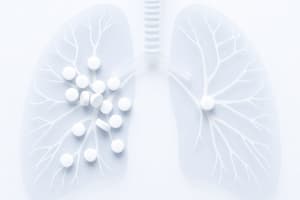Podcast
Questions and Answers
What is the primary pharmacodynamic effect of Angiotensin II Receptor Blockers (ARBs)?
What is the primary pharmacodynamic effect of Angiotensin II Receptor Blockers (ARBs)?
- Decrease myocardial oxygen demand
- Increase sodium and water retention
- Inhibit calcium ion movement
- Block Angiotensin II receptors (correct)
What nursing consideration is critical when administering Calcium Channel Blockers?
What nursing consideration is critical when administering Calcium Channel Blockers?
- Ensure the patient avoids grapefruit juice (correct)
- Avoid administering on an empty stomach
- Administer with potassium supplements
- Monitor for renal function
What is the primary pharmacodynamic action of nitrates?
What is the primary pharmacodynamic action of nitrates?
- Block sodium channels
- Increase myocardial oxygen demand
- Relax vascular smooth muscle (correct)
- Decrease intracellular calcium
Which of the following drugs is classified as a Beta Blocker?
Which of the following drugs is classified as a Beta Blocker?
Which antiarrhythmic drug class primarily blocks sodium channels?
Which antiarrhythmic drug class primarily blocks sodium channels?
What is a significant nursing consideration for patients taking Diuretics?
What is a significant nursing consideration for patients taking Diuretics?
Which of the following is an adverse effect associated with Vasodilators?
Which of the following is an adverse effect associated with Vasodilators?
What nursing consideration is crucial when administering Ranolazine?
What nursing consideration is crucial when administering Ranolazine?
Which beta-blocker action primarily reduces myocardial oxygen demand?
Which beta-blocker action primarily reduces myocardial oxygen demand?
What essential parameter should be monitored when using Renin Inhibitors?
What essential parameter should be monitored when using Renin Inhibitors?
Which condition is NOT an indication for Beta Blockers?
Which condition is NOT an indication for Beta Blockers?
What is a common nursing consideration for Class III antiarrhythmics?
What is a common nursing consideration for Class III antiarrhythmics?
What mnemonic can be used to remember the pharmacological effect of ARBs?
What mnemonic can be used to remember the pharmacological effect of ARBs?
What mechanisms do Calcium Channel Blockers utilize in the treatment of arrhythmias?
What mechanisms do Calcium Channel Blockers utilize in the treatment of arrhythmias?
Which of the following is the primary indication for Digoxin?
Which of the following is the primary indication for Digoxin?
What pharmacodynamic effect is associated with Amiodarone?
What pharmacodynamic effect is associated with Amiodarone?
What is the primary function of gastrin in the digestive system?
What is the primary function of gastrin in the digestive system?
Which of the following correctly describes the function of histamine 2 receptors?
Which of the following correctly describes the function of histamine 2 receptors?
What triggers the process of peristalsis in the gastrointestinal tract?
What triggers the process of peristalsis in the gastrointestinal tract?
What results from putrefaction in the colon?
What results from putrefaction in the colon?
What is the correct sequence of the upper gastrointestinal tract?
What is the correct sequence of the upper gastrointestinal tract?
Which statement best describes the role of the nervous plexus?
Which statement best describes the role of the nervous plexus?
Which of the following processes is primarily associated with the expulsion of food from the stomach?
Which of the following processes is primarily associated with the expulsion of food from the stomach?
What is the role of cAMP in pharmacodynamics related to muscle contraction?
What is the role of cAMP in pharmacodynamics related to muscle contraction?
Which function is primarily associated with the large intestine?
Which function is primarily associated with the large intestine?
Where does carbohydrate digestion initially begin?
Where does carbohydrate digestion initially begin?
What triggers the vomiting reflex?
What triggers the vomiting reflex?
Which of the following is NOT an accessory organ in the digestive system?
Which of the following is NOT an accessory organ in the digestive system?
What enzyme is responsible for protein digestion starting in the stomach?
What enzyme is responsible for protein digestion starting in the stomach?
What role does the gall bladder play in digestion?
What role does the gall bladder play in digestion?
Which reflex stimulates the intestines following stomach stretching?
Which reflex stimulates the intestines following stomach stretching?
Which statement correctly describes fat digestion?
Which statement correctly describes fat digestion?
What is the primary action of histamine 2 receptor antagonists like Ranitidine?
What is the primary action of histamine 2 receptor antagonists like Ranitidine?
Which nursing consideration is important when administering anti-emetics?
Which nursing consideration is important when administering anti-emetics?
What is a potential side effect of proton pump inhibitors like Omeprazole?
What is a potential side effect of proton pump inhibitors like Omeprazole?
Which of the following is a characteristic of anti-peptic drugs like Sucralfate?
Which of the following is a characteristic of anti-peptic drugs like Sucralfate?
What is the primary effect of laxatives such as Bisacodyl?
What is the primary effect of laxatives such as Bisacodyl?
What nursing consideration is crucial for patients taking antacids?
What nursing consideration is crucial for patients taking antacids?
What is a common side effect associated with opioids used for gastrointestinal issues?
What is a common side effect associated with opioids used for gastrointestinal issues?
Which parameter should be monitored to prevent complications from GI medications?
Which parameter should be monitored to prevent complications from GI medications?
What is the primary function of bulk-forming agents in gastrointestinal treatments?
What is the primary function of bulk-forming agents in gastrointestinal treatments?
Which class of drugs is used to suppress the vomiting center in the brain?
Which class of drugs is used to suppress the vomiting center in the brain?
What is a common side effect associated with H2 blockers, such as Ranitidine?
What is a common side effect associated with H2 blockers, such as Ranitidine?
Which anti-diarrheal agent works by decreasing peristalsis in the colon?
Which anti-diarrheal agent works by decreasing peristalsis in the colon?
What crucial nursing consideration should be taken when administering antacids?
What crucial nursing consideration should be taken when administering antacids?
Which mechanism do 5-HT3 receptor blockers primarily utilize?
Which mechanism do 5-HT3 receptor blockers primarily utilize?
Which of the following drugs is indicated for patients experiencing gastroesophageal reflux disease (GERD)?
Which of the following drugs is indicated for patients experiencing gastroesophageal reflux disease (GERD)?
What impact do opium derivatives have on gastrointestinal motility?
What impact do opium derivatives have on gastrointestinal motility?
Flashcards
ACE Inhibitors
ACE Inhibitors
Lower blood pressure by blocking the conversion of angiotensin I to angiotensin II, a potent vasoconstrictor.
ARBs (Angiotensin II Receptor Blockers)
ARBs (Angiotensin II Receptor Blockers)
Lower blood pressure by blocking angiotensin II receptors, preventing vasoconstriction and aldosterone release.
Calcium Channel Blockers
Calcium Channel Blockers
Lower blood pressure by preventing calcium from entering cells in blood vessels, causing vasodilation and reducing workload on the heart.
Beta Blockers
Beta Blockers
Signup and view all the flashcards
Vasodilators
Vasodilators
Signup and view all the flashcards
Diuretics
Diuretics
Signup and view all the flashcards
Renin Inhibitor
Renin Inhibitor
Signup and view all the flashcards
Nursing Considerations (General)
Nursing Considerations (General)
Signup and view all the flashcards
Nitrates
Nitrates
Signup and view all the flashcards
Beta-Blockers (Angina)
Beta-Blockers (Angina)
Signup and view all the flashcards
Calcium Channel Blockers (Angina)
Calcium Channel Blockers (Angina)
Signup and view all the flashcards
Ranolazine
Ranolazine
Signup and view all the flashcards
Class I Antiarrhythmics
Class I Antiarrhythmics
Signup and view all the flashcards
Amiodarone (Class III)
Amiodarone (Class III)
Signup and view all the flashcards
Digoxin (Cardiac Glycoside)
Digoxin (Cardiac Glycoside)
Signup and view all the flashcards
Milrinone (Phosphodiesterase)
Milrinone (Phosphodiesterase)
Signup and view all the flashcards
Pharmacodynamics of Milrinone
Pharmacodynamics of Milrinone
Signup and view all the flashcards
Milrinone Indications
Milrinone Indications
Signup and view all the flashcards
Gastrin Function
Gastrin Function
Signup and view all the flashcards
H2 Receptors Function
H2 Receptors Function
Signup and view all the flashcards
Local Gastric Reflexes Function
Local Gastric Reflexes Function
Signup and view all the flashcards
Nervous Plexus Function
Nervous Plexus Function
Signup and view all the flashcards
Putrefaction Definition
Putrefaction Definition
Signup and view all the flashcards
Vomiting Function
Vomiting Function
Signup and view all the flashcards
Large Intestine Function
Large Intestine Function
Signup and view all the flashcards
Lower GIT Function
Lower GIT Function
Signup and view all the flashcards
Carbohydrate Digestion Start
Carbohydrate Digestion Start
Signup and view all the flashcards
Protein Digestion Start
Protein Digestion Start
Signup and view all the flashcards
Fat Digestion Location
Fat Digestion Location
Signup and view all the flashcards
Gastroenteric Reflex
Gastroenteric Reflex
Signup and view all the flashcards
Parasympathetic Nervous System Effect
Parasympathetic Nervous System Effect
Signup and view all the flashcards
Sympathetic Nervous System Effect
Sympathetic Nervous System Effect
Signup and view all the flashcards
Bismuth subsalicylate
Bismuth subsalicylate
Signup and view all the flashcards
Opium derivatives
Opium derivatives
Signup and view all the flashcards
Phenothiazines (e.g., Prochlorperazine)
Phenothiazines (e.g., Prochlorperazine)
Signup and view all the flashcards
Non-phenothiazine anti-emetics (e.g., Metoclopramide)
Non-phenothiazine anti-emetics (e.g., Metoclopramide)
Signup and view all the flashcards
5-HT3 Receptor Blockers (e.g., Ondansetron)
5-HT3 Receptor Blockers (e.g., Ondansetron)
Signup and view all the flashcards
Histamine 2 Receptor Antagonists (e.g., Ranitidine)
Histamine 2 Receptor Antagonists (e.g., Ranitidine)
Signup and view all the flashcards
Proton Pump Inhibitors (PPI) (e.g., Omeprazole)
Proton Pump Inhibitors (PPI) (e.g., Omeprazole)
Signup and view all the flashcards
Laxatives
Laxatives
Signup and view all the flashcards
Bulk-forming Laxatives
Bulk-forming Laxatives
Signup and view all the flashcards
Lubricant Laxatives
Lubricant Laxatives
Signup and view all the flashcards
Loperamide
Loperamide
Signup and view all the flashcards
Nonphenothiazines (e.g., Metoclopramide)
Nonphenothiazines (e.g., Metoclopramide)
Signup and view all the flashcards
Anticholinergics/Antihistamines (e.g., Meclizine)
Anticholinergics/Antihistamines (e.g., Meclizine)
Signup and view all the flashcards
Study Notes
Drugs for Upper Respiratory Tract Conditions
-
Antihistamines (Treat Allergies):
- First-generation (Sedating): Chlorphenamine, Diphenhydramine
- Cross the blood-brain barrier → Cause drowsiness
- Used for runny nose, sneezing, and allergic reactions
- Second-generation (Non-Sedating): Claritin, Cetirizine
- Do not cross the blood-brain barrier → Less likely to cause drowsiness
- Preferred for daytime allergy relief
- Mnemonic: First-gen: "Drowsy Diphenhydramine Dreams." Second-gen: "Clear with Claritin."
- First-generation (Sedating): Chlorphenamine, Diphenhydramine
-
Drugs for Common Colds (Nasal Decongestion):
- Phenylephrine: Constricts blood vessels in nasal passages → Reduces swelling and congestion
- Caution: Prolonged use may cause rebound congestion (rhinitis medicamentosa)
- Mnemonic: "Phenylephrine Fights Flared Nostrils."
-
Cough Drugs:
- Expectorants (Thin mucus): Guaifenesin
- Loosens mucus, making it easier to cough up
- Antitussives (Cough Suppressants):
- Non-narcotic: Dextromethorphan, Butamirate → Suppress cough reflex without addiction
- Narcotic: Codeine → Stronger but risk of dependency
- Expectorants (Thin mucus): Guaifenesin
Drugs for Lower Respiratory Tract Conditions
-
Bronchodilators (Relieve Airway Constriction):
- Xanthine Derivatives: Aminophylline (theophylline derivative)
- Therapeutic range: 10-20 mcg/mL
- Signs of toxicity:
- Nausea (>20 mcg/mL)
- Tremor (>35 mcg/mL)
- Sympathomimetic Bronchodilators:
- Short-acting (SABA): Albuterol → Rapid relief (onset: 20 min, lasts 4-6 hrs)
- Long-acting (LABA): Terbutaline → Preventative (lasts 12 hrs)
- Anticholinergic Bronchodilators: Ipratropium Bromide
- Reduces airway constriction by blocking parasympathetic signals
- Mnemonic: "X, S, A for Airways" → Xanthine, Sympathomimetic, Anticholinergic.
- Xanthine Derivatives: Aminophylline (theophylline derivative)
-
Steroids (Control Inflammation):
- Examples: Beclomethasone, Hydrocortisone, Prednisone
- Key Considerations:
- Use bronchodilators first, then steroids (to open airways for steroid absorption)
- Rinse mouth after inhalation (to prevent oral thrush)
- Never abruptly stop steroids → Always taper off.
Anti-Asthma Drugs
- Leukotriene Receptor Antagonists: Montelukast
- Reduces inflammation and airway constriction caused by leukotrienes
- Used for long-term asthma control
- Mast Cell Stabilizers: Cromolyn Sodium
- Prevent histamine release from mast cells
- Used as a preventative measure in asthma
- Mnemonic: "Montelukast & Mast Cell Stabilizers Manage Asthma."
Nursing Considerations for Respiratory Drugs
- Teach breathing and coughing techniques to clear secretions
- Encourage hydration (8+ glasses/day) to loosen mucus
- Positioning: Upright for easier breathing
- Monitor vital signs (BP and HR, especially with bronchodilators)
- Encourage smoking cessation to improve drug effectiveness
Quick Memory Tips
- ABCD for Bronchodilators:
- A: Aminophylline (Xanthine)
- B: Bronchodilators (SABA/LABA, Anticholinergic)
- C: Corticosteroids
- D: Drugs for cough (Expectorants/Antitussives)
- PEMM for Mucus Management:
- P: Phenylephrine (Decongestant)
- E: Expectorants (Guaifenesin)
- M: Mucolytics (Carbocisteine)
- M: Mast cell stabilizers (Cromolyn Sodium)
Studying That Suits You
Use AI to generate personalized quizzes and flashcards to suit your learning preferences.




